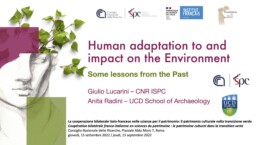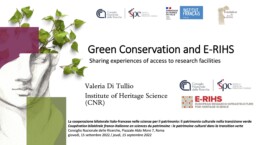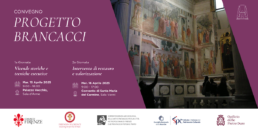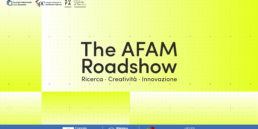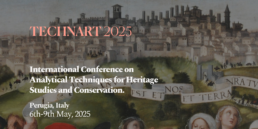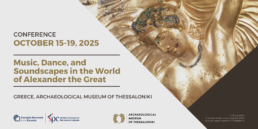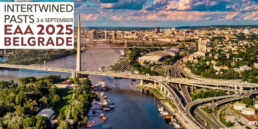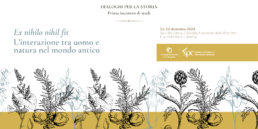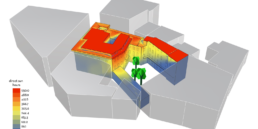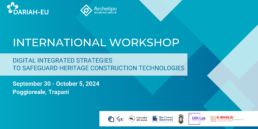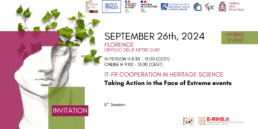La cooperazione bilaterale italo-francese nelle scienze per il patrimonio:
il patrimonio culturale nella transizione verde
15 settembre 2022 | ore 9:00-13:00
Incontro ibrido | virtuale e in presenza
ROMA, Consiglio Nazionale delle Ricerche, Piazzale Aldo Moro 7, sala Marconi
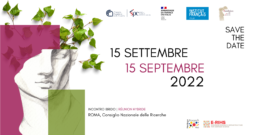
Sulla scia dell’impulso dato dal Trattato del Quirinale che enfatizza il settore dei beni culturali come ambito di cooperazione tra Italia e Francia, l’Istituto di Scienze del Patrimonio Culturale del Consiglio Nazionale delle Ricerche, la Fondation des Sciences du Patrimoine con l’Institut Français Italia, l’Ambasciata di Francia in Italia sono lieti di invitarvi a un incontro di lavoro sul ruolo del patrimonio culturale nella transizione verde che si terrà giovedì 15 settembre presso il Consiglio Nazionale delle Ricerche, Roma.
L’incontro s’inserisce nella cooperazione bilaterale italo-francese sulle scienze del patrimonio che si basa sull’eccellenza riconosciuta di entrambi i Paesi e su diverse iniziative di ricerca congiunte a lungo termine. L’Italia ospiterà la sede legale dell’Infrastruttura Europea per le Scienze del Patrimonio E-RIHS, che si sta costituendo come Consorzio per un’Infrastruttura di Ricerca Europea (ERIC) entro il 2023. La Francia è alla guida dell’iniziativa di programmazione congiunta Cultural Heritage and Global Change JPI CH e del progetto che porterà alla creazione di un’Alleanza per la ricerca sul patrimonio culturale in Europa ARCHE.
L’incontro si propone di riunire ricercatori italiani e francesi che lavorano nel campo delle scienze del patrimonio culturale sull’urgente questione del cambiamento climatico, del suo impatto sul patrimonio culturale e di come il patrimonio culturale possa essere un motore di resilienza, un capitale di conoscenza e una fonte di creatività e innovazione per la transizione ecologica.
L’incontro bilaterale sarà il primo di una serie, e prenderà le mosse dal libro bianco per la ricerca sul patrimonio culturale e il cambiamento climatico pubblicato dalla JPI Cultural Heritage e dalla JPI Climate nel 2022 (White Paper. Cultural Heritage and Climate Change: New challenges and perspectives for research), che presenta una serie di argomenti per ulteriori ricerche e propone anche un elenco di strumenti da mettere in atto per accompagnare lo sviluppo di questo settore scientifico e sostenere le attività delle organizzazioni impegnate nell’azione per il clima.
Una ventina di rappresentanti del mondo della ricerca e della cultura dell’Italia e della Francia saranno invitati a partecipare e a contribuire al dibattito. Tra questi, saranno coinvolti anche giovani dottorandi in scienze chimico-fisiche, scienze umane e sociali, economia. Vi invieremo l’elenco dei partecipanti qualche giorno prima dell’incontro.
Il formato dell’incontro, che sarà in modalità ibrida (virtuale e in presenza), prevede due panel successivi di 1h30 ciascuno, durante i quali quattro relatori, due italiani e due francesi, presenteranno le sfide del loro lavoro, che saranno il punto di partenza della discussione e di scambio fra i partecipanti. L’ordine del giorno dettagliato della riunione sarà comunicato successivamente.
Lingue di lavoro: Italiano, Francese e Inglese
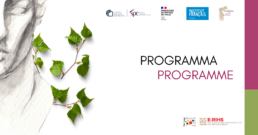
Qui potete trovare le presentazioni dei relatori intervenuti all'evento
Resilienza e adattamento
Il patrimonio culturale come fonte di conoscenza, creatività e innovazione per la transizione ecologica
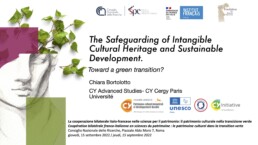
The Safeguarding of Intangible Cultural Heritage and Sustainable Development. Toward a green transition?
Conceptualized as “living heritage” and characterized by intrinsic links with the economy, environment, and society, Intangible Cultural Heritage (ICH) explicitly introduces new issues and concerns within the realm of heritage policies, which go far beyond those conventionally associated with conservation. Drawing on participant observation of ICH governance within the governing bodies of the Convention for the Safeguarding of the ICH on the one hand, and of the preparation of a nomination to the UNESCO Representative List in an Italian town on the other hand, I shed light on the disruptions in heritage representations when heritage work becomes more about making plans for the future than engaging with the past. In tackling the temporality regime underpinning ICH, this paper highlights an important paradigm shift from “conservation” aimed at perpetuating authenticity to “safeguarding,” entailing instead the integration of change. I argue that this shift not only challenges established heritage theory and practice, but opens up new possibilities for accelerating a green transition.
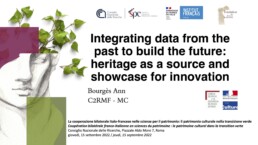
Intégrer les données du passé pour construire le futur: le patrimoine une source et une vitrine d’innovation
Le patrimoine est souvent aussi source d’inspiration, inspiration en ce qui concerne les matériaux utilisés, les techniques, l’artisanat, les savoir-faire. Les biens matériels et immatériels sont aussi un atout, un outil d’innovation pour apporter de nouvelles solutions. En s’inspirant du passé et des richesses vertueuses de notre patrimoine, les solutions de préservation, mais aussi de mieux vivre sont à portée de main. Il y a autant à faire dans l’identification des effets que dans l’identification des potentialités innovantes qu’offre le patrimoine.
Le mouvement européen du New Bau Haus en témoigne et le patrimoine a un immense rôle à jouer dans ces actions pour la réduction de nos émanations de gaz à effet de serre. Le patrimoine doit être une vitrine d’innovation, répertoriant l’ensemble des matériaux et des techniques vertueuses pouvant s’intégrer dans l’objectif principal du pacte vert européen, le zéro carbone pour 2050. Intégrer les données du passé pour mieux bâtir l’avenir dès aujourd’hui.
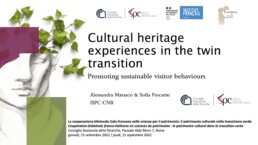
Cultural heritage experiences in the twin transition: promoting sustainable visitor behaviours
The role of cultural heritage in inspiring action for climate mitigation and sustainable futures is an emerging area of research (JPI Cultural Heritage & JPI Climate, 2022). Visitors represent an important target audience for raising awareness and encouraging behavioural change towards more sustainable practices to protect cultural heritage, reduce environmental impacts and reach climate neutrality goals (Potts, 2021; Markham et al., 2016). Promoting sustainable visitor behaviours for the conservation of cultural heritage and the environment is thus a strategic priority for cultural heritage institutions, but remains challenging, particularly with regard to how sustainable behaviours can be integrated in the design of visitor-centred experiences (Ardoin, Schuh, and Khalil, 2016).
With the aim to contribute to the debate in this field, this presentation focuses on how to promote sustainable visitor behaviours through cultural heritage experiences from the twin transition perspective. It provides insights into the understanding of sustainable visitor behaviours, key antecedents identified by literature and the opportunities offered by digital technologies. Building on an experience design approach (Tussyadiah, 2014, 2017), guiding principles are presented for designing experiences involving digital technologies that are effective in encouraging and engaging visitors in sustainable behaviours.
Conservazione verde
Il patrimonio culturale come vettore di innovazione per la sostenibilità ecologica
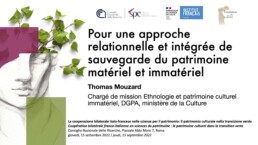
Pour une approche relationnelle et intégrée de sauvegarde du patrimoine matériel et immatériel
La sauvegarde du patrimoine culturel immatériel (PCI) contribue par définition à la transition verte car en application de la Convention Unesco de 2003 elle doit respecter les objectifs du développement durable (DD), dont l’écologie est l’un des 3 axes. D’après les Directives opérationnelles révisées en 2016, les Etats partie s’efforcent ainsi de « renforcer le rôle du PCI en tant que facteur et garant du DD ». Après avoir synthétisé les grandes orientations et principes de cet instrument normatif international dans ce domaine, cette communication commencera par présenter un bilan sommaire et les enjeux qui se posent en France dans leur mise en œuvre. Dans un troisième temps, nous aborderons le problème d’un point de vue anthropologique en mettant en évidence l’impossibilité à répondre aux défis écologiques de notre temps sans reconsidérer nos modes de relations au vivant, et sortir de la double dichotomie humanité / nature, modernités / traditions.
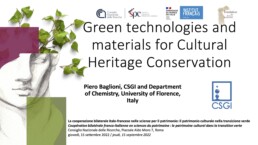
Green technologies and materials for Cultural Heritage Conservation
European Cultural Heritage (CH) is a crucial resource that must be maintained, preserved and accessible, to counteract degradation enhanced by unfavorable environmental conditions and climate changes. Traditional conservation methodologies lack durability, sustainability and cost-effectiveness, and are typically based on energy-consuming processes or non-environmentally friendly materials.
Coping with these issues, new solutions based on green and sustainable materials and methods, to preserve, conserve and restore have been proposed and will be further developed within the “green matrix” and the European Green deal. In this talk I will briefly highlight: 1) Protective coatings based on green materials from waste and plant proteins, with self-heling and reversibility character, possibly functionalized with organic/inorganic nanoparticles to impart VOC capture, anti-corrosion and barrier behaviors; 2) Foams and packaging materials made by biodegradable/compostable polymers from renewable sources to control T/RH. 3) Consolidants based on natural polymers from renewable sources, to mechanically strengthen weak artifacts. 4) Gels and cleaning fluids inspired by the most advanced systems currently available to conservators, improving them according to green and circular economy.
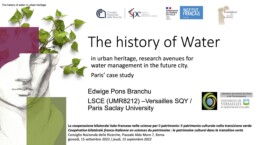
L’histoire de l’eau dans le patrimoine urbain, des pistes de recherche pour la gestion de l’eau dans la ville future
Dans les zones densément peuplées, le développement urbain a un impact important sur la qualité des eaux naturelles, et en particulier de celles des nappes de proche surface. La qualité de ces eaux est mal connue, tout comme les facteurs qui l’influence (sources de pollution par exemple), et ne sont pas utilsées comme ressource. Nous présentons ici l’étude des eaux de proche surface de Paris et ses environs. L’approche innovante développée dans le cadre de plusieurs projets visait à mettre en place les outils analytiques pour reconstruire l’évolution historique de la qualité des eaux. Celle-ci s’appuie sur l’étude de fins dépôts calcaires formés par les eaux d’infiltration au cours du temps et retrouvés dans les aqueducs historiques, les catacombes ou autre structure souterraine. Il est ainsi possible de retracer l’évolution temporelle de certaines sources de pollution en lien avec les aménagements urbains ou les activités humaines, et mieux les contraindre. Cette approche est aussi en cours pour l’étude des eaux alimentant les fontaines du château de Versailles.
Cette méthodologie pourrait être appliquée à d’autres sites en France et en Italie. En effet, la meilleure connaissance de l’histoire des eaux urbaines ou zones fortement anthropisées permet de discuter de leur possible valorisation comme ressource alternative, dans un contexte de raréfaction de la ressource en eau.
Références sur les projets
